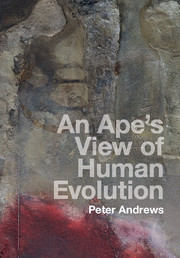Book contents
- Frontmatter
- Contents
- Preface
- 1 How can we recognize common ancestors?
- Part I Apes: their morphology and behaviour
- PART II Environments and palaeoenvironments
- 5 Structure and composition of ape environments
- 6 Environmental indicators
- Part III Review of fossil apes
- Part IV Last common ancestor
- References and further reading
- Index
- References
6 - Environmental indicators
from PART II - Environments and palaeoenvironments
Published online by Cambridge University Press: 05 January 2016
- Frontmatter
- Contents
- Preface
- 1 How can we recognize common ancestors?
- Part I Apes: their morphology and behaviour
- PART II Environments and palaeoenvironments
- 5 Structure and composition of ape environments
- 6 Environmental indicators
- Part III Review of fossil apes
- Part IV Last common ancestor
- References and further reading
- Index
- References
Summary
When we discover a new fossil hominid, we want to know more than just what it is called. We want to know what it did, how it lived, what it ate and what kind of environment it lived in. All these are the subject of palaeoecology, the study of the inferred interactions between past organisms and their environments. These interactions provide evidence on the relationship between palaeoenvironments and fossil apes and fossil humans, and they are essential to the understanding of how evolution operates. In other words, it is not enough simply to know that a particular fossil existed at a time and place and that it might be ancestral to later forms, for this tells us little about how it lived and how it functioned in its environment. For this we need to attempt to reconstruct the environment with which it was associated and its place in the ecosystem. For human evolution in particular, we would like to know whether we are descended from forest apes or woodland savanna apes, whether we became bipedal in wooded environments or in open savanna, whether we learned our social behaviour in trees or on the ground, whether we have vegetarian ancestry or were meat‐eaters, and many other questions that can only be anwered if we know what kind of environment we evolved in.
There are several lines of inquiry providing evidence on past environments and those that are most useful in interpreting fossil ape and human environments are briefly reviewed here. Some like sediment or faunal analyses may be directly linked with hominid remains, but others are only rarely found associated with hominid fossils. Some lines of inquiry have limitations that have to be considered, for example community analysis of point versus regional assemblages, fossilized ecosystems and accounting for bias in fossil faunas. It is generally recognized that mammals may not be the best source of evidence on hominid palaeoecology, but at least they are consistently there, and it is for this reason that so much work has gone into devising new ways of extracting ecological information from mammalian faunas.
- Type
- Chapter
- Information
- An Ape's View of Human Evolution , pp. 82 - 118Publisher: Cambridge University PressPrint publication year: 2016



